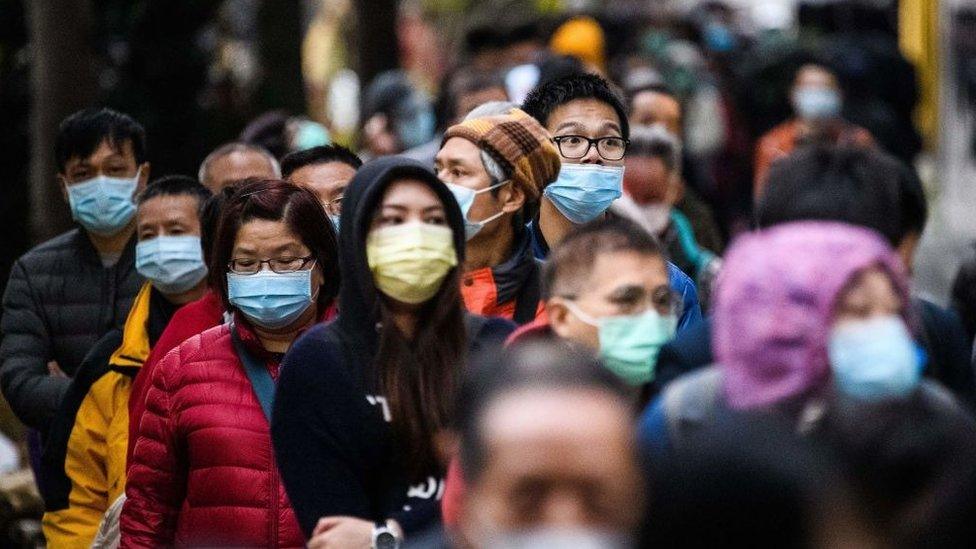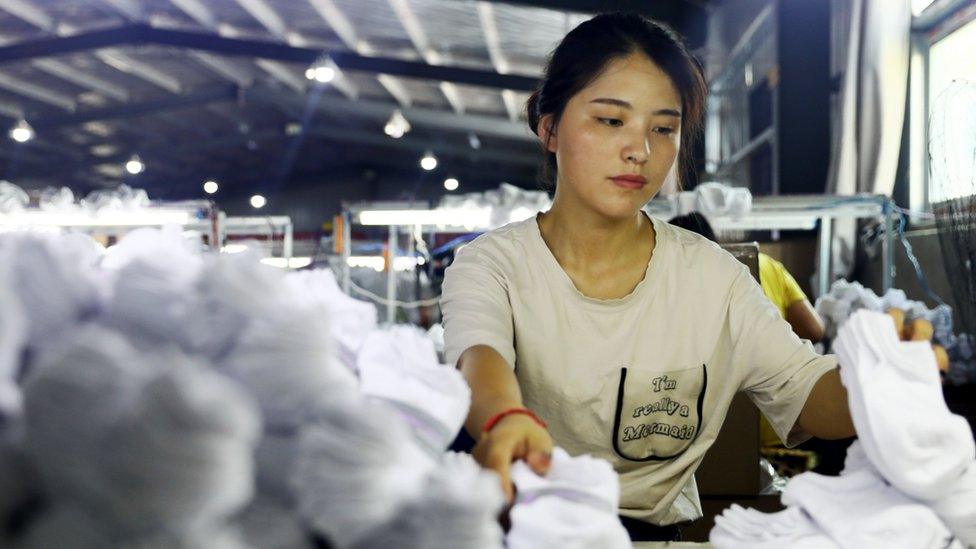China GDP: Bleak outlook for economic recovery post-virus
- Published

Workers eating during lunch break at the Dongfeng Honda plant in Wuhan in China's central Hubei province
China put its economy into a self-induced coma to fight the virus. Now it's slowly getting back to work, but don't expect that to save the rest of us. It won't be enough as the latest numbers show us.
China's GDP shrank by 6.8% for the first three months of the year - its first year-on-year contraction in decades, in fact since records started. It's a sign of how hard it will be to restart all our economies.
First off, China's economic data always comes with the caveat: don't believe what you read. Independent economists always say the figures are much lower than what the government says. But this year's first-quarter economic data was always going to be bad.
They confirm that the lockdown exacted unavoidable significant pain on the economy. But it doesn't end here. Almost every economist I've spoken to says that things will get worse before they get better.
So if you were hoping that any growth momentum in the coming quarters will help the rest of us - think again.
The World Bank says in the base case scenario, China will see growth fall to 2% this year from 6% last year - and if things get worse, it would see growth fall to 0.1%. That's basically no growth.
Whatever Beijing manages to eke out from now will not be enough for the rest of us to hitch our wagons to in the hopes of a recovery.
Back to business
Despite the grim first-quarter news, companies are starting to get back to work in China - albeit slowly.
In a survey of its members from the end of March, the American Chamber of Commerce in China, external said that nearly a quarter of their companies expect a return to normal business operations by the end of April, while 22% had already resumed normal operations.
Some 40% say they will keep their investment levels in line with what had previously been planned - so no job cuts there or scaling back of factories.
That momentum is being mirrored on a much greater scale domestically.
"Last month, my contacts in China said they weren't going out, period," Vinesh Motwani, managing director of Silk Road Research told me.
"Now, they're slowly going back to work - and even grabbing after-work beers."
Mr Motwani says the data he's tracked is encouraging, showing that most businesses in China will be back to 100% by May, with demand somewhere in the 60-100% range, depending on the industry.

An aerial view of the roads and bridges in Wuhan city, China during the coronavirus lockdown
But almost 20% of China's economy is made up of exports, according to data from the World Bank in 2018, external - selling goods to the rest of us.
Global demand is key to its recovery. And with most of Europe, the US and UK - its biggest customers - at home during the lockdown, there's not much optimism about that kicking back in anytime soon.
Low demand everywhere
When China put parts of the country in lockdown in January, starting with Wuhan and then extending to other cities, the proverbial excrement "hit the fan", as one Singapore-based exporter told me.
He sources 90% of his goods from China - everything from kitchen gadgets to cleaning items. Demand from his American customers was soaring, but because of the lockdown, he couldn't source anything. He had to tell his customers in the US that we had no idea when the lockdown might end.
But fast-forward two months and "it's as if nothing happened", he says.
"Factories are fulfilling orders in record time," he said. "And now the things I'm sourcing are masks and hand sanitisers - that's the only thing my customers in the US want. Factories that made kitchen supplies before are now making masks."
That demand from the rest of the world IS showing up in data from China. Shipments picked up last month as factories reopened, according to think tank Capital Economics.
But it warned that "with economic activity in the rest of the world now collapsing", the worst is still to come for China's export sector.
Foreign demand will slump this quarter, the think tank says, as Covid-19 weighs on economic activity outside China.
And it's no use hoping that the Chinese consumer will help to shore up China and the global economy.
'What is now holding the economy back is a lack of demand,' says AXA Investment Manager's Aidan Yao.
"This problem is particularly acute in consumer services industries, as social distancing keeps people away from restaurants, movie theatres and tourist sites."
AXA says a recent broker survey of large services firms shows that while 75% to 85% of supply has been restored, demand is only running at 50% to 55% of normal levels. And many companies don't expect full normality at home to return until the second half of the year.
Risk to recovery
On top of all of those challenges, new coronavirus cases and re-infections are risking China's tepid economy recovery. It is clear the government hasn't ruled out locking down clusters or hot spots again if it needs to, which could lead to more severe economic outages in the future.
"China's governance system allowed it to go through a hard lockdown nationwide," says Mr Motwani, "with a very gradual resumption of activity over the course of two months as it prioritised containment over economic activity."
China itself won't be immune to job losses either. The official unemployment rate - which at the best of times is highly doubted - rose to 6.2% in February, its highest on record.
Beijing does have the firepower to fight some of this, specifically to help out its small and medium-sized enterprises.
The central bank has been cutting some of China's interest rates: short-term loans to corporates jumped in March after this. But survival is key for these firms right now - and more help may be needed to give these companies a lifeline.
In the last global financial crisis, China spent close to $600bn (£478bn) on stimulus, and that helped to lift the rest of the world's economic engine. But that also put massive debt risk into the Chinese system - something Beijing simply doesn't have the appetite for right now.
Which means banking on China's growth to help the rest of us get through the worst economic downturn since the Great Depression is not just unrealistic, it's risky. China has enough problems of its own to focus on.
- Published16 April 2020

- Published1 April 2019

- Published16 April 2020
